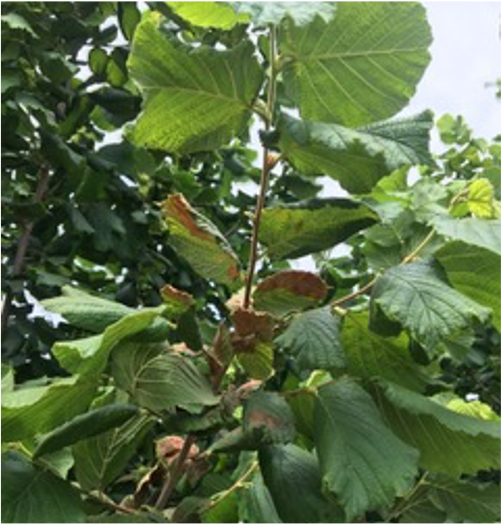A few years ago, the Oregon hazelnut industry added a new tool to use against big bud mite: micronated dry flowable sulfur. There are several special local needs labels for different brands that you can find in the Hazelnut Pest Management Guide. There are at least two bud mite species that affect Oregon hazelnuts; Phytocoptella avellanae and Cecidophyopsis vermiformis. These mites originated from Europe/Eurasia and probably arrived in Oregon on the first nursery stock of European hazelnut that was imported. They cause galls to form in buds, which are highly apparent in spring. The galls often kill the buds and they fall from the tree, leaving blind wood. Sometimes the infested buds are able to successfully develop, but growth may be abnormal. Some hazelnut varieties are resistant and never have any issue, but others that are widely planted are highly susceptible.
The use of sulfur replaced some of the older, more broadly toxic chemistries, and the dry flowable (DF) formulation can be easier to use than lime sulfur products and is cheaper than some of the other miticides. We used it successfully in multiple trials with no problems and we got decent control. The residues can be long-lived on the foliage, which helps with timing the applications to coincide with the spring mite migration, which is the hard-to-predict vulnerable period when the mites leave the galls and migrate to new axillary buds on developing shoots.
The downside of sulfur is that it can burn in hot weather (read your labels!). We found this out big time in the heat dome of 2021 (June 24-29) when it reached 116 F for three consecutive days in the North Willamette Valley. Trees that had not been treated in weeks had severe burn and defoliation. Luckily we caught this in our trial and we saw no burn from single applications of up to 15 lbs, but severe burn from two applications of the 10lb rate. We noted from growers that high rates of sulfur DF and multiple applications caused severe burn in some orchards. There may have been some interaction with adjuvants as well.
With hot weather up ahead and bud mite management season upon us, I just wanted to throw this reminder out there, use caution! If there was a silver lining, the heat (and perhaps the burn) definitely set the mites back. We had not a single blasted bud in our trial orchard the following spring of 2022 and it has taken until 2023 for the mite populations to recover.







